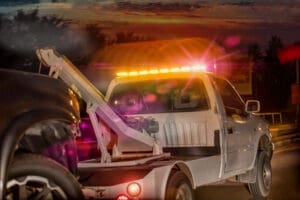As a tow truck company owner, it is crucial to be well-versed in the laws governing tow trucks and their lighting systems. No matter where you are in the world, these laws exist to prioritize the safety of both tow truck operators and other motorists. While this article focuses on the United States, you should review the codes relevant to your city or district to make sure you and your team members all have a thorough understanding of tow truck lighting laws.
 Common Tow Truck Lighting Laws
Common Tow Truck Lighting Laws
Among the most heavily regulated aspects of tow trucks are their lighting systems. State and local agencies across the country impose tow truck lighting laws regarding warning light colors for tow trucks. The majority of these agencies mandate that stock lighting, including headlights, taillights, and backup lights, be white. Conversely, rear-facing lights and side markers on the rear of tow trucks are typically required to be red. Furthermore, specific states necessitate the use of oscillating, strobe lights, or rotating lights, specifying either a particular color or a combination of colors. In several states, tow trucks must be equipped with oscillating, rotating, or strobe lights of a specified color. Additionally, certain states even mandate the use of two different colors for tow truck lights.
New Laws to Increase Safety
Recent years have witnessed the implementation of new tow truck lighting laws across various states aimed at bolstering the safety of tow truck operators. Notably, in 2023, Washington State Senate Bill 5023 was unanimously passed, granting tow-truck operators the ability to use rear-facing blue flashers at accident scenes, in addition to the red flashers already permitted by law. The primary objective of this bill is to enhance the safety of tow truck drivers while they work in Washington State. Similarly, Pennsylvania Act 157 of 2022 legalized the use of blue flashing lights as a replacement for amber lights on tow trucks. This legislative change grants tow truck operators an additional layer of safety during highway crash scenes, ensuring better visibility and awareness among other motorists.
Emergency Lights
Another key distinction between tow trucks and regular vehicles lies in the use of emergency lights. While tow truck operators are obligated to equip their trucks with revolving or flashing lights, activation of these lights is only permitted when the vehicle is actively engaged in tasks for which it received its designation as an emergency vehicle or when operating near an emergency response area. Consequently, tow truck drivers can only utilize red and blue lights in response to emergencies.
Collins is your partner for business success.
You might wonder why Collins is interested in tow truck lighting laws. Truth is, if it’s important to our clients, it’s important for us, too. We’ve worked with our towing clients for decades, so we feel an obligation to provide our clients with help to make their businesses as successful as possible. Collins Manufacturing has been the industry leader in towing equipment for 45 years. Our Hi-Speed® Dolly and Carrier Dolly systems make towing vehicles from even the most challenging situations safe and simple for your crew. Our safety ratchet system prevents injuries to employees from slipping grips and prevents the vehicle from dropping. When your workplace and employees’ safety matters, choose Collins. Contact us today to learn how you can implement Collins towing equipment in your company.

Leave a Reply